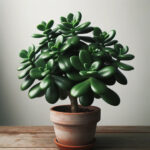Have you ever stumbled upon a plant that looks like it’s straight out of a fairy tale? Enter Crassula capitella.
Often dubbed the “Campfire Plant,” its vibrant red and green hues can ignite any garden or indoor space. Imagine a chilly evening, sitting by a campfire, and the warm, fiery glow it emits. Now, picture that same glow, but in the form of a plant. That’s Crassula capitella for you.
But what makes this succulent so special? Why are plant enthusiasts around the world raving about it?
Let’s dive deep into the world of Crassula capitella, uncovering its secrets and understanding why it’s a must-have for every plant lover out there.
History and origins of the Crassula Capitella
Ever wondered where the enchanting Crassula capitella hails from? Let’s take a trip back in time.
Originating from the vast landscapes of southern Africa, this succulent has roots (pun intended) that run deep into history. Imagine ancient tribes, using the vibrant leaves of Crassula capitella in rituals or as ornamental pieces in their dwellings.
But it’s not just about the past. Over the years, this plant has journeyed across continents, finding its way into the hearts and gardens of many. From the arid plains of its homeland to the bustling urban jungles of modern cities, Crassula capitella has proven its adaptability and charm.
Why the widespread love, you ask? Well, its unique appearance, combined with its resilience, makes it a favorite among both novice gardeners and seasoned horticulturists.
So, the next time you gaze upon your Crassula capitella, remember the rich tapestry of history it carries with it. A true testament to nature’s wonders, this plant is more than just a pretty face.
Physical Characteristics
When you first lay eyes on Crassula capitella, its physical characteristics are sure to leave you in awe.
Leaf Shape and Color
The leaves are where the magic happens. Arranged in a tight rosette, they start off a lush green and gradually transform into a fiery red as they bask in the sun. It’s like watching a painter brush strokes of red onto a green canvas.
Growth Pattern
But it’s not just about the colors. The growth pattern of Crassula capitella is a sight to behold. As it grows, it forms a dense mat, creating a carpet of red and green that can add a pop of color to any garden or indoor space.
Flowering Details
And let’s not forget about the flowers. During the summer months, Crassula capitella blooms with clusters of tiny, star-shaped flowers. It’s as if the plant is celebrating the warm season, adorning itself with nature’s jewelry.
Seasonal Changes
The seasonal changes of Crassula capitella are what truly make it stand out. From the green hues of spring to the fiery red of summer, and then back to green in the fall, it’s a year-round spectacle.
So, whether you’re a seasoned gardener or a newbie with a budding green thumb, Crassula capitella is sure to capture your heart with its unique physical characteristics.
Ideal growing conditions
So, you’ve fallen for the allure of Crassula capitella and want to give it the best home possible? Let’s delve into the ideal conditions that’ll make your plant thrive.
Soil Type and pH Level
First things first: the foundation. Crassula capitella isn’t too picky, but it does have a soft spot for well-draining soil. Think of it like building a house on solid ground. You wouldn’t want your precious plant sitting in waterlogged soil, would you? A mix of cactus soil with some perlite or sand does the trick. And as for pH? Aim for a slightly acidic to neutral range.
Light Requirements
Sunlight is to Crassula capitella what coffee is to many of us: essential. This succulent loves basking in bright, indirect light. Picture it lounging by a window, soaking up the rays but without the scorch of direct noon sun. Too much direct sunlight, and its leaves might get sunburned (yes, plants can get sunburned too!). Too little, and it might lose its vibrant colors.
Temperature and Humidity Preferences
Now, let’s talk climate. Crassula capitella is like that friend who always brings a jacket, just in case. It prefers mild temperatures, ideally between 60°F to 75°F. And humidity? Low to moderate is the sweet spot. Imagine a day at the beach, where it’s not too muggy but not bone-dry either.
In essence, understanding the ideal growing conditions for Crassula capitella is like decoding the preferences of a dear friend. With the right care and environment, this plant won’t just survive; it’ll flourish.
Planting and Propagation of the Crassula Capitella
Alright, green thumbs, let’s get our hands dirty with Crassula capitella!
Step-by-Step Guide to Planting
Starting with the basics: planting. Imagine setting up a cozy bed for a dear friend. That’s what we’re doing for our Crassula capitella.
- Choose a pot with good drainage. Think of those summer rain showers; you wouldn’t want your plant sitting in a puddle.
- Fill the pot with the well-draining soil mix we discussed earlier. Remember, it’s all about that solid foundation.
- Make a small hole in the center, gently place your Crassula capitella, and cover its roots with soil.
- Water it lightly. Think of it as a welcome drink for your new plant buddy.
Propagation Methods
Now, the fun part: propagation. Ever thought of multiplying the beauty of your Crassula capitella? Here’s how:
Leaf Cuttings
- Gently twist off a healthy leaf from the mother plant. It’s like plucking a grape from a bunch.
- Let it dry for a day or two. This helps the cut end callous, preventing rot.
- Place the dried leaf on the soil, without burying it. In time, you’ll see tiny roots and a baby plant emerging!
Offsets
Got a mature Crassula capitella? You might notice baby plants, or offsets, growing at its base.
- Gently separate these offsets with a clean knife.
- Plant them in their own pots. Voila! New plants!
Seeds
Feeling adventurous? Try growing Crassula capitella from seeds.
- Sprinkle the seeds on the soil surface.
- Keep the soil moist but not soggy.
- With patience, you’ll see tiny green sprouts making their debut.
Tips for Successful Growth
A quick tip before we wrap up: Consistency is key. Regularly check on your Crassula capitella, ensuring it’s not too thirsty or sunburned. With love and care, you’ll see it grow and multiply, adding beauty to your space.
In the world of plants, Crassula capitella is like that versatile actor who shines in every role. Whether you’re planting or propagating, this succulent is sure to steal the show.
Crassula Capitella Care and Maintenance
So, you’ve got your Crassula capitella settled in its new home. But like any prized possession, it needs some TLC to truly shine.
Watering Frequency
Watering is where most plant parents go astray. Think of Crassula capitella as that friend who prefers sipping on their drink rather than downing it in one go. It’s better to underwater than overwater. Wait until the soil is dry to the touch, then give it a good soak. Imagine it as a refreshing spa day for your plant after a long dry spell.
Fertilization
When it comes to food, Crassula capitella isn’t a big eater. A light feeding with a succulent fertilizer during the growing season will do. It’s like treating your plant to a gourmet meal every once in a while. But remember, moderation is key. Too much, and you might end up with a bloated plant.
Pruning and Reshaping
Over time, your Crassula capitella might start to look a bit wild, like hair in need of a trim. Pruning helps in two ways:
- It keeps the plant looking neat and tidy.
- It encourages more robust and bushier growth. Using clean scissors, snip off any leggy stems or overgrown areas. It’s like giving your plant a fresh new haircut, ready to flaunt its beauty.
A Few Words of Wisdom
Every plant has its quirks, and Crassula capitella is no exception. It might throw a tantrum with droopy leaves or go on a growth hiatus. But with observation and understanding, you can decode its needs. Remember, it’s not just about keeping it alive but helping it thrive.
In the grand tapestry of plant care, Crassula capitella stands out as a resilient yet graceful gem. With the right care and maintenance, it’ll reward you with its mesmerizing beauty, day in and day out.
Common Pests and Diseases
Ah, the challenges of plant parenthood! While Crassula capitella is a resilient beauty, it’s not immune to the occasional pest or disease. But fear not! With a keen eye and some know-how, you can keep these unwelcome guests at bay.
Identifying Common Pests
Mealybugs
Ever spotted tiny, cotton-like clusters on your Crassula capitella? Meet the mealybugs. They’re like those uninvited guests who crash your party and refuse to leave. They suck the sap out of the plant, causing it to weaken. But with a simple swipe of rubbing alcohol on a cotton swab, you can bid them goodbye.
Spider Mites
Tiny spider-like creatures weaving fine webs on your plant? Spider mites are the culprits. Think of them as mini vampires, draining the life out of your Crassula capitella. A good shower or a spray of insecticidal soap can send them packing.
Diseases That Might Affect Crassula Capitella
Root Rot
If your plant looks droopy and the roots smell foul, it might be facing the dreaded root rot. It’s like catching a cold due to prolonged exposure to wet conditions. The remedy? Repotting in fresh, dry soil and ensuring proper drainage can nurse it back to health.
Fungal Infections
Spotted black or white spots on the leaves? It could be a fungal infection, often due to high humidity. Imagine it as your plant’s version of catching a flu. Keeping the plant dry and applying a fungicide can help it recover.
Prevention and Treatment Methods
An ounce of prevention is worth a pound of cure. Regularly inspect your Crassula capitella, ensuring it’s free from pests and diseases. And if trouble does strike, act swiftly. With the right care, your plant can bounce back, stronger and more vibrant.
In the vast realm of plant care, understanding the common pests and diseases is crucial. But with vigilance and love, your Crassula capitella will continue to dazzle and delight.
Benefits and Uses of the Crassula Capitella
Beyond its undeniable beauty, Crassula capitella brings a bouquet of benefits and uses to the table. Let’s unravel the tapestry of wonders this plant offers.
Aesthetic Appeal
Crassula capitella is like that statement piece in a room that instantly draws attention. Its vibrant hues and unique growth pattern can elevate any space, be it a minimalist apartment or a sprawling garden. Imagine a room painted in neutral tones. Now, add a pot of Crassula capitella. Instantly, the room comes alive, echoing nature’s artistry.
Air Purification
Did you know plants are nature’s air purifiers? Crassula capitella, with its lush leaves, helps filter the air, removing toxins and releasing fresh oxygen. It’s like having a natural air freshener that not only looks good but also boosts your well-being.
Therapeutic Benefits
Ever felt a wave of calm wash over you when tending to plants? Crassula capitella, with its soothing colors, can be a balm for the soul. Tending to it, watching it grow, can be a meditative experience, grounding you in the present moment. Think of it as a form of green therapy, a respite from the digital chaos of modern life.
Cultural Significance
In some cultures, succulents like Crassula capitella are symbols of resilience and endurance. Gifting one can be a gesture of admiration, acknowledging someone’s strength and perseverance. It’s like gifting a medal, but in plant form.
In the grand mosaic of nature, Crassula capitella shines not just for its beauty but also for its myriad benefits and uses. Whether you’re seeking aesthetic charm, cleaner air, or a touch of tranquility, this plant delivers in spades.
Varieties and Similar Species
The world of Crassula capitella is vast and varied, much like the universe of fine wines or artisanal cheeses. Dive in with me as we explore its diverse cousins and close relatives.
Different Types of Crassula Capitella
Crassula Capitella ‘Campfire’
This variety is the showstopper, with leaves that turn from green to brilliant red. Imagine the embers of a campfire, glowing and warm. That’s this plant in all its glory.
Crassula Capitella ‘Thyrsiflora’
Also known as “Red Pagoda,” this one boasts of tightly stacked leaves that resemble a pagoda’s structure. It’s like the architectural marvels of ancient Asia, but in plant form.
Comparison with Similar Species in the Crassula Family
Crassula Ovata (Jade Plant)
Often mistaken for Crassula capitella, the Jade Plant has thicker, rounder leaves. Think of Crassula capitella as the slender, graceful ballet dancer, while the Jade Plant is the robust, sturdy weightlifter.
Crassula Arborescens (Silver Dollar Plant)
With silvery-blue leaves, this species stands out in the Crassula family. It’s like the shimmering gown amidst a sea of red and green dresses.
Why the Diversity Matters
The diverse varieties and similar species of Crassula capitella offer a palette of choices for plant enthusiasts. Whether you’re curating a garden or decorating an indoor space, there’s a Crassula out there that fits the bill. It’s like having an array of paint colors at your disposal, each bringing its unique shade and texture to the canvas.
In the botanical realm, Crassula capitella and its kin are a testament to nature’s creativity and diversity. Each variety and species tells its own story, adding layers of depth and beauty to our green spaces.
FAQs about Crassula Capitella
Ah, the burning questions! When diving into the world of Crassula capitella, it’s natural to have a few queries. Let’s tackle some of the most common ones, shall we?
Is Crassula Capitella Easy to Care For?
Absolutely! Think of it as that low-maintenance friend who’s always a joy to hang out with. With basic care and a bit of love, Crassula capitella thrives, making it perfect for both newbie plant parents and seasoned gardeners.
How Often Should I Water It?
Less is more here. Imagine treating your plant to a spa day, but only when it really needs it. Wait for the soil to dry out between waterings, and you’ll have a happy, hydrated plant.
Can It Survive in Low Light?
While Crassula capitella loves the spotlight, it’s not a fan of the dark. It’s like trying to read a book in dim lighting; not ideal. Bright, indirect light keeps it vibrant and healthy.
Is Crassula Capitella Toxic to Pets?
A crucial question for our furry friends! While it’s not known to be highly toxic, it’s always best to keep plants out of pets’ reach. Think of it as childproofing, but for your four-legged family members.
Why Are the Tips of My Plant Turning Brown?
Ah, the classic sign of sunburn. Yes, plants can get sunburned too! It’s like lounging at the beach without sunscreen. Shift your Crassula capitella to a spot with indirect light, and it should recover in no time.
Navigating the world of Crassula capitella can be a journey filled with questions. But with a dash of curiosity and a sprinkle of knowledge, you’ll be well-equipped to give your plant the best life possible.
Conclusion
And there we have it, the mesmerizing world of Crassula capitella unraveled!
From its rich history to its vibrant hues, this plant is truly a marvel of nature. It’s like discovering a hidden gem in a vast desert, shimmering and radiant.
But beyond its beauty, Crassula capitella tells a story. A story of resilience, adaptability, and the wonders of the natural world. Imagine a ballet dancer, gracefully twirling and leaping, captivating the audience with every move. That’s Crassula capitella, dancing its way through seasons, challenges, and time.
Whether you’re a seasoned gardener or someone just dipping their toes into the world of plants, Crassula capitella offers lessons and joys in abundance. It’s a testament to the magic that unfolds when we nurture and care, when we observe and learn.
So, as we wrap up our journey, let’s carry forward the wonder and curiosity that Crassula capitella inspires. For in every leaf, every bloom, lies a universe waiting to be explored.



